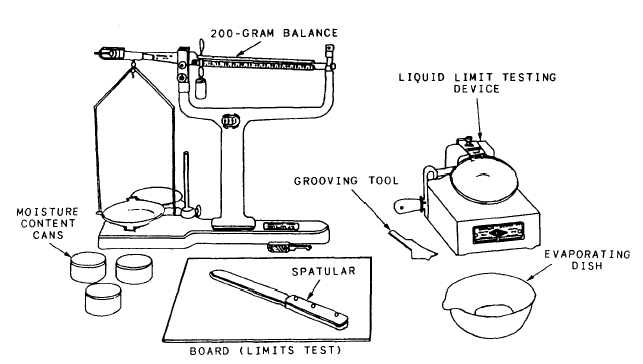the moisture content (WL) at the upper limit of
the plastic range, expressed as a percentage. The
plastic limit (PL) is the moisture content at the
lower limit of the plastic range.
Test Equipment
Figure 15-34 shows equipment for determin-
ing the Atterberg limits of a soil sample. The
LIQUID LIMIT TESTING DEVICE consists of
a brass bowl mounted on a box type of apparatus.
When you turn the crank, the apparatus elevates
the bowl containing the sample and then drops
it downward a specific distance onto the hard-
rubber anvil of the testing device. Each of these
drops is called a BLOW. We will explain the pur-
pose of the procedure as we describe the test.
TeBst Procedure
The liquid and plastic limit tests normally are
conducted only on the portion of the soil that
passes the No. 40 sieve. A few particles that are
large enough to be retained on the No. 40 sieve
do not cause serious difficulty. However, it is
generally faster to remove these larger particles
by hand by kneading the soil between the fingers.
If the percentage of particles retained on the No.
40 sieve is higher, these particles must be removed
by passing the soil through the No. 40 sieve. Do
not oven-dry or subject the sample to any artificial
drying before you process or test it.
Soak the sample in water for 24 hr before
washing. Then wash it through the No. 40 sieve
and collect it in a large evaporating dish or col-
lecting can. Oven-dry the material retained on the
sieve, then dry-sieve it through the No. 40 sieve.
Combine the portion dry sieved through the No.
40 sieve with the material washed through the
sieve; the combined material is used for the tests.
Break up soil particles that are lumping together
or adhering to aggregate particles and separate
them by rubbing them with your hands.
Next, dry the sample to approximately the
liquid limit by decanting or blotting the water off,
by evaporating it off (taking care to stir the soil
frequently during evaporation), or by a combina-
tion of both procedures.
After this, place the soil mass in the liquid limit
testing device cup, and divide it into sections by
a central groove made with the grooving tool (fig.
15-34). The water content at the liquid limit is the
water content at which the soil mass makes con-
tact for a distance of 1/2 in. when the cup is
dropped 25 times (25 blows) for a distance of 1 cm
(0.3937 in.) at a rate of two drops per second.
First, adjust the machine for this drop distance
as follows:
A metric gauge is located on the handle of the
grooving tool. The machine has an ADJUST-
MENT PLATE and a pair of ADJUSTMENT
Figure 15-34.-Apparatus for determining Atterberg limits.
15-30



